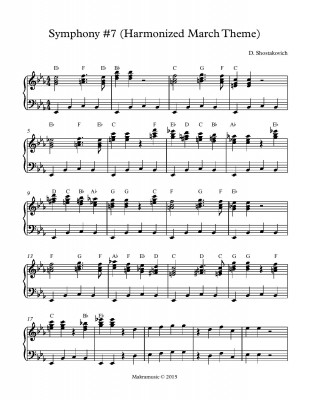I probably listen to more Classical music than anything; I have a few reasons for it but I won’t list them here. Recently, I re-discovered Shostakovich’s 7th Symphony “Leningrad”; I think I decided to pick it up again after I had a long conversation with a friend about World War II and how it changed Europe and the rest of the world.

Quick Fact: Shostakovich completed and premiered the Symphony in the midst of the horrific Nazi siege of Leningrad which lasted 900 days and produced all kinds of human tragedies. (check the bottom of the page for info links on the Leningrad siege).
As I listened to the Symphony day after day, I became more and more caught up in the March theme (a.k.a: “Invasion” theme) that appears in the middle of the first movement. Basically, it is a beautiful and simple melody that is repeated through many variations until you finally can’t get it out of your head (reminiscent of Ravel’s “Bolero”).
However, of all the variations, I was most intrigued when the violins take up the melody in what sounded like an incredibly complex harmonization that produced an ambiguous polytonal effect to my ears. So naturally, I had to satisfy my curiosity by getting the complete score and analyzing that section in particular. I found that Shostakovich had achieved that overwhelming sound with a most simple solution: Major Triads. Each note of the melody becomes the root of a major triad, i.e, an F in the melody will be harmonized with a C (perfect fifth) and an A (major thirds), a G will be harmonized with D and B, and so forth. Sounds simple, but here’s what comes out:
If you really would like to understand what is happening here, I simplified the process to be able to play it on the piano. I suggest you try playing it yourself to really hear the sound and absorb it. First, let’s look at the melody and the bass line alone, you can download the scores by clicking on the PDF:
Simplified March Theme (PDF):

Now, simply by filling in the space between the bass line and the melody with major triads, we get a polytonal effect through parallel motion:
Harmonized March Theme (PDF):

The reason it sounds polytonal is because, in fact, we have the same melody being played in three different tonalities (keys). The original melody in in Eb-major. The first voice below the melody, is the same melody transposed to the key of Bb-major. The second voice below the melody, is again the same melody but transposed to G major. Eb, Bb, G forms a corresponding Eb-major triad and all the other notes form corresponding major triads as I’ve written on top of each note. While the top 3 voices are moving in parallel major triads, the bass-line remains somewhat static in Eb-major, which I believe contributes beautifully in terms of contrast.
Applying the concept to other melodies:
I took this idea and began applying it to other melodies. Below you’ll find that I tried using major triads exclusively, minor triads exlusively and also mix of both. The melodies are “Happy birthday”, “Ode to Joy” and “Frère Jacques”. You can experiment yourself with other melodies and triads such as diminished and augmented.
3 Melodies harmonized in Triads (PDF)

Futher readings on Wikipedia:



https://waterfallmagazine.com
I am really inspired along with your writing abilities
and also with the structure on your weblog. Is that this a paid subject matter or did you modify it yourself?
Anyway stay up the nice high quality writing, it is
uncommon to peer a nice weblog like this one nowadays..
Thank you for the kind comment! I’m sorry it took so long to reply. The weblog is a featuer of One.com which I use for my website.